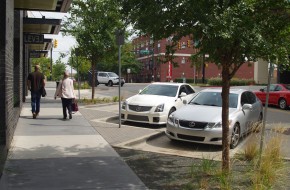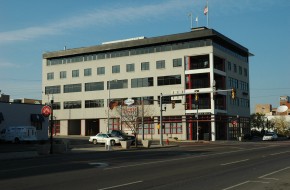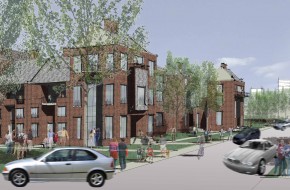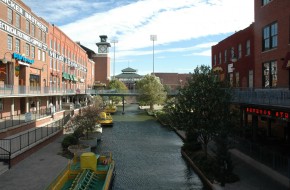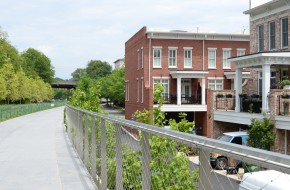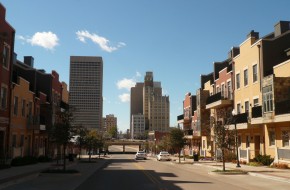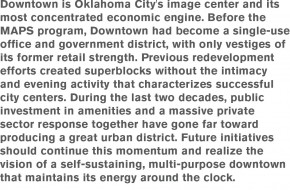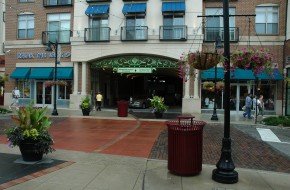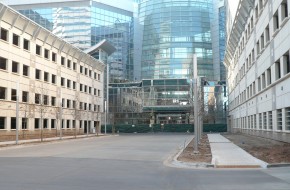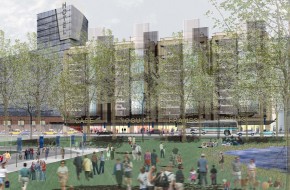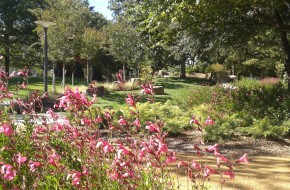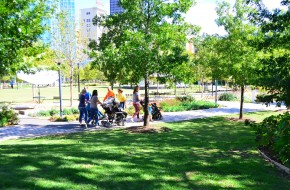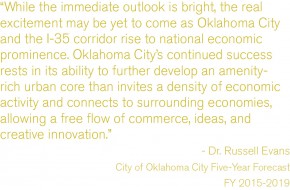The initiatives below relate to Downtown. Click on any initiative to view a full explanation and related policies.
We will provide incentives and investments that produce a favorable environment for private investment on underutilized sites. In Oklahoma City, we have tended to view land as an inexhaustible and disposable resource, reducing the desirability of older areas and decreasing land values, while expanding the city's boundaries outward. The surveys and process of planokc show that this view is also changing, as citizens place a high value on using existing infrastructure and urban land effectively and rebuilding established neighborhoods. Preferences are also changing, as many families appreciate active urban places like Midtown and Automobile Alley that provide living, shopping, entertainment, and work places with good walking, bike, and transit access. Effective use of existing land resources is a central principle of Chapter Two's land use vision.
Redevelopment and infill depend on major private investment. City policy and action can create the conditions that help this private investment occur.
Directions for these policies include:
- Site assembly. Multiple property owners, often absent or very difficult to find, can make it impossible to put together sites for redevelopment. The City can help private developers by helping them assemble sites.
- Infrastructure and street improvement. While redevelopment and infill sites usually have infrastructure, these facilities are sometime obsolete and require improvement. Redevelopment can provide the impetus for making necessary public investments in these assets.
- Public investments. Parks, schools, civic facilities, pedestrian and bicycle facilities, streetscapes, and other amenities can provide anchors that are proven to generate private development. The Bricktown Canal is an excellent example of a public amenity that has paid for itself many times over in private investment. Similarly, the new MAPS 3 Park will inevitably become the catalyst for the Core to Shore redevelopment.
- Code improvement and proactive enforcement. Poor property maintenance, unattractive and cluttered signs, and public or operating nuisances can degrade the value of surrounding property and discourage reinvestment. Updated ordinances and consistent, enforcement will minimize these disincentives and create momentum for new private development.
Click to expand policy information.
Establish new incentives and raise awareness of existing incentives that stimulate the preservation and rehabilitation of historic resources. Incentives could include:
- Preservation easements, low-interest or forgivable rehabilitation loans, and Tax Increment Financing Districts for historic buildings, sites, and districts.
- Tools and practices for public/private partnerships to ensure the preservation and retention of top-priority historic resources whose deterioration or demolition would present an irreparable and highly significant loss to the City and beyond.
- Existing city, state, and federal tools and incentives for rehabilitation, including state and federal tax credits for certified rehabilitation.
- Expedited review process for projects involving infill sites.
Support and incentivize the adaptive use of existing buildings, infill development, and brownfield development.
Modify codes and/or regulations to create opportunities for more income diversity and mixed-income neighborhoods by allowing a variety of housing ownership and leasing arrangements, diverse housing sizes and types – including accessory dwelling units, carriage homes, lofts, live-work spaces, cottages, and manufactured/modular housing. Modifications should allow an increase the variety of ownership opportunities to include condominiums, ownership cooperatives (such as mutual housing associations, limited equity cooperatives, etc.) by identifying and removing regulatory barriers. Recommend improvements to protections for owners, developers, and lenders.
Priority should be given to projects that achieve efficiencies described elsewhere in planokc, such as dwelling units that are located to have easy access to each other and to other daily needs including jobs, recreation, and schools.
Maximize the use of all appropriate state, federal, local, and private funding for the development, preservation, and rehabilitation of housing affordable to a variety of income groups, including those that integrate low-income housing units in otherwise market-rate housing developments and support the creation and/or expansion of mixed-income communities.
Integrate housing rehabilitation programs with neighborhood revitalization programs. These programs should include assistance to property owners to renovate the existing housing stock with improvements that reduce utility and maintenance costs for owners and occupants, conserve energy, conserve water, and reduce greenhouse gas emissions.
Establish new or expand existing financing methods and/or mechanisms available to new and redevelopment mixed-income projects in urban areas. These could include: direct investment of public housing funds, tax-increment financing, bonds, revolving loans, housing program funds and/or other proven public-private partnership models.
Create and/or enhance Community Development Corporations (CDCs) and Community Housing Development Organizations (CHDOs) to increase their capacity to provide mixed-income housing, especially in targeted infill areas.
Reuse brownfield, greyfield, and other vacant building sites to provide new opportunities for mixed-used and mixed-income housing.
Prevent concentration of low-income populations by providing housing opportunities for all income groups in targeted redevelopment areas of the city with a particular focus on mixed-income projects, especially on those projects that have a public funding component.
In conjunction with City regulatory changes, such as significant modifications to zoning ordinances, building codes, or subdivision regulations, assess the effects of the proposed modifications on housing development costs and overall housing affordability, considering the balance between housing affordability and other objectives such as environmental quality, urban design quality, maintenance of neighborhood character and protection of public health, safety and welfare. This assessment should be integrated into the code amendment process, identify barriers to housing affordability, and include recommended mitigation.
Add legislative priorities for state laws to:
- Strengthen the City’s ability to obtain specific performance of property owners cited for code violations.
- Speed up the demolition process for long-time boarded properties that cannot be rehabilitated.
- Strengthen the City’s ability to require property owners to rehabilitate or sell neglected, boarded-up properties.
- Expedite the clearing of properties involved in probate.
Strategically use subsidized housing programs along with other City services and programs to revitalize targeted areas of the city.
Support infill development on vacant, underutilized, and brownfield sites by:
- Allowing densities sufficient to incentivize infill in older areas
- Focusing resources on target neighborhoods to build positive momentum
- Evaluating and adjusting zoning in areas where infill is desired
- Reducing permit fees and processing time for infill development proposals
- Waiving the requirement for traffic impact analyses for infill development proposals
- Establishing an Abandoned Buildings Program and enhancing it over time by:
- Seeking changes in City ordinance and State statute where necessary to allow for cost recovery of police and fire services costs caused by vacant buildings
- Using revenue collected beyond Vacant and Abandoned Buildings program administration cost for neighborhood improvements
- Submitting land bank legislation to the State Legislature and establishing a land bank authorized to acquire, rehabilitate, and dispose of abandoned properties
- Offering temporary or short term catalyzing incentives for the first “infillers” in target neighborhoods. Incentives may include small grants and/or low interest loans from a revolving loan fund or for property improvements.
- Evaluating the possibility of basing property taxes on only land value and not improvements, thereby encouraging high intensity use of well-positioned land and discouraging underutilization and long–term vacancy.
Mitigate negative impacts of compactness by:
- Updating nuisance code to better address noise, smell, vibration, property maintenance, panhandling, animal control, delivery hours limits, and other possible negative effects.
- Updating the sign ordinance to reduce visual clutter.
Prioritize and concentrate development where facilities, infrastructure, and services have capacity and in areas where the Police and Fire Departments are best able to respond. Guide the location and timing of development through the proactive and strategic installation of infrastructure.
Create and implement small area plans for neighborhoods or districts with special strategic importance or complications related to development or redevelopment.
Identify priority areas where the City can maximize private investment by providing public infrastructure and amenities including:
- Transit;
- Parks, trails, sidewalks;
- Streets;
- Arts and cultural facilities.
Encourage redevelopment and infill development on vacant, underutilized, and brownfield sites in urbanized areas.
Catalyze infill development on vacant, underutilized, and brownfield sites in urbanized areas by:
- Investing in infrastructure improvements;
- Improving multi-modal transportation networks;
- Improving parks and open spaces;
- Improving schools and other civic resources;
- Exploring innovative methods such as:
- A public-private partnership to purchase problem properties in target areas and build or rehabilitate homes while improving infrastructure and amenities
- An infill house plan program similar to Sacramento or Milwaukee
- Identifying and removing barriers to rehabilitation and/or replacement of residential buildings.
- Establishing a position in the City to facilitate medium- and large-scale redevelopment projects through the development process by guiding interactions with City departments, allied agencies, and utility companies.
Encourage the adaptive reuse of underutilized structures and the revitalization of older, economically distressed neighborhoods.
We will continue the process of creating a mixed-use, intensively developed, human-scaled, and experience-rich downtown. American downtowns declined as the number of reasons that brought people downtown decreased. Recently, downtowns have achieved success as places to live and visit as well as work. This evolution in Oklahoma City began in Bricktown and surrounding areas, where the canal and ballpark anchored adaptive reuse of historic buildings and the addition of new restaurants, entertainment venues, hotels, offices, and homes. This transformation continued with the addition of one of the National Basketball Association's premier franchises, the Civic Center restoration, major office projects, and new housing. While the growth and development of downtown will always be ongoing, these accomplishments provide the foundation for building a great 21st century downtown.
Land use and development targets and policies will be instrumental in guiding this future. Major land use focuses will include a range of housing types and costs to serve a complete cross-section of the Oklahoma City market; services and retailing that support a larger resident population, including child care, educational facilities, and neighborhood commercial uses like a grocery store; integration of multiple uses into new and existing buildings; and public parks and open spaces for both programmed and informal activity. Much of this future development will occur on currently under-used sites such as the Core to Shore redevelopment area, the future Boulevard on the former I-40 right-of-way; existing surface parking lots, and vacant sites. Initial steps in meeting these needs include revisions of regulations to accelerate desirable uses and market research to demonstrate and quantify markets for specific project types.
As Downtown continues to develop, it must also evolve as a great urban place that offers a superb experience to its residents, workers, and visitors. The history of the urban renewal era in Oklahoma City tells us that investment dollars and big projects alone do not create a living and vibrant city center. A secure, populated, human-scaled environment requires family-friendly amenities, windows on the street, buildings with details scaled to people, pedestrian environments that engage the eye and mind, and an overall sense of welcoming and even festivity. These features have the power to attract the life that is characteristic of great downtowns.
Click to expand policy information.
Promote the downtown area as an attractive place to live and play for all household types, including families with children by:
- Requiring human scale site and building designs
- Focusing on pedestrian friendliness
- Adding family-friendly public amenities including parks, open space, greenways, plazas, bikeways, public art, etc.
- Limiting noise and protecting privacy
- Ensuring new buildings and sites are designed to be attractive and to enhance safety and the sense of safety.
- Encouraging employment and residential uses in close proximity
- Encouraging or requiring a percentage of condominium or apartment units to be 2 and 3 bedroom units
- Encouraging “child-friendly” development near schools and discouraging uses that could be detrimental to schools’ viability
- Instituting on-street police officers on foot or bicycle to maintain “eyes on the street” and enhance public safety and security
Attract and retain young professionals to downtown and its environs to support and enhance place-making efforts and investments.
- Explore the possibility of the Greater Oklahoma City Chamber of Commerce contracting with the City to facilitate and promote civic engagement and social opportunities for young professionals.
Facilitate the development of housing in the Downtown, Bricktown, and Core to Shore areas in order to increase activity levels and demand for retail and amenities.
Strengthen downtown’s sense of place and activity levels by encouraging more housing, retail, public plazas, public art, parks, indoor recreation facilities, and arts and cultural facilities.
Increase land use diversity in Bricktown to attract and retain visitors and development momentum. Specifically, encourage more retail, office, and recreational uses rather than additional bars and restaurants, so that visitors of all ages and interests will be motivated to visit and stay longer.
In order to promote compatibility between different uses, establish standards and guidelines that ensure all developments are pedestrian-friendly and human scale at street frontages and property lines.
Enhance Downtown Oklahoma City’s prominence by maintaining and increasing its role as the major business center, establishing it as a major urban residential center, and focusing on developing retail, office, entertainment, and arts and cultural uses.
Continue to pursue a full scale downtown grocery store or a natural food grocer by:
- Increasing the amount of downtown housing
- Conducting a market study to quantify existing and future potential
- Promoting downtown to potential store operators
- Providing incentives such as land, infrastructure, or sales tax rebates, and allowing for mixed-use (vertical) integration with other uses including, but not limited to, residential.
Encourage development of new educational and childcare facilities downtown to accommodate families with children that work and/or live downtown.
In Downtown and adjacent areas, encourage the development of affordable housing for moderate-income households through incentives or requirements such as:
- Requiring a percentage of units in all new apartment and condominium developments to be affordable to working households with incomes of 80 to 100 percent of the area median family income as defined by the U.S. Department of Housing and Urban Development. Developments may be exempted through payment of an in-lieu fee to go towards development of affordable housing.
- Establishing a density bonus program where appropriate.
- Establishing financial incentives for development of affordable housing.
Evaluate existing regulations for effectiveness in promoting density and mixed-use development and in addressing surface parking. Develop a new urban design code for downtown and other key districts to promote healthy mixes of land uses that are compatible and complementary.
We will create a high-density downtown by providing efficient parking, excellent automobile, bicycle, and pedestrian circulation, and development policies that promote density.
We know that private automobile transportation and the space that cars require work against high-density development. We also know that downtown must accommodate private cars to succeed, but should provide better alternatives for people moving between features within the district. High density development itself brings more things closer together, making walking, biking (including bike share systems), and transit circulators like modern streetcars the most efficient and pleasant ways to go.
We can institute this "virtuous cycle" by:
- Redeveloping surface parking lots with new development, providing new parking in parking structures, and integrating structured parking vertically into new projects.
- Developing enhanced transit to downtown and "density-friendly" circulation to points within downtown, including pedestrian and bicycle facilities (including bike share) and the modern streetcar circulator included in the MAPS 3 capital program.
- Preserving and restoring to the degree possible the urban grid of blocks in Downtown Oklahoma City, re-establishing pedestrian linkages lost during the superblock era of Downtown redevelopment.
- Revising development ordinances to limit surface parking, encourage mixed uses on at least the street level of parking garages, and increase overall development yields.
Click to expand policy information.
Maintain existing alleys or construct new alleys where feasible to provide trash collection service and parking behind primary buildings and minimize curb cuts along the primary street frontage.
Prohibit new single-use, on-street commercial surface parking lots from locating Downtown and create incentives for the redevelopment of existing commercial surface parking lots with appropriately-scaled infill development.
Provide incentives for developers to build parking garages in high density areas. Include design requirements for projects receiving incentives.
Evaluate existing regulations for effectiveness in promoting density and mixed-use development and in addressing surface parking. Develop a new urban design code for downtown and other key districts to promote healthy mixes of land uses that are compatible and complementary.
We will implement the Core to Shore redevelopment plan. Core to Shore, linking Downtown with the Oklahoma Riverfront, is an exceedingly important project for many reasons. Its 800 acres will develop a completely new, mixed income residential neighborhood that can add up to 10,000 people to the immediate Downtown market. The MAPS 3 Downtown Upper and Lower Parks, other green spaces, and the SkyDance bridge will provide open space and recreation for the entire downtown community and will unite the riverfront greenway and the city center. Finally, the boulevard, convention center, and associated development will heal a barrier that has long divided downtown from its surrounding neighborhoods. Other cities such as Chicago with the redevelopment of the South Loop have demonstrated the dramatic impact of district-wide redevelopment adjacent to a major downtown. Core to Shore is that kind of historic project for Oklahoma City.
Click to expand policy information.
Support infill development on vacant, underutilized, and brownfield sites by:
- Allowing densities sufficient to incentivize infill in older areas
- Focusing resources on target neighborhoods to build positive momentum
- Evaluating and adjusting zoning in areas where infill is desired
- Reducing permit fees and processing time for infill development proposals
- Waiving the requirement for traffic impact analyses for infill development proposals
- Establishing an Abandoned Buildings Program and enhancing it over time by:
- Seeking changes in City ordinance and State statute where necessary to allow for cost recovery of police and fire services costs caused by vacant buildings
- Using revenue collected beyond Vacant and Abandoned Buildings program administration cost for neighborhood improvements
- Submitting land bank legislation to the State Legislature and establishing a land bank authorized to acquire, rehabilitate, and dispose of abandoned properties
- Offering temporary or short term catalyzing incentives for the first “infillers” in target neighborhoods. Incentives may include small grants and/or low interest loans from a revolving loan fund or for property improvements.
- Evaluating the possibility of basing property taxes on only land value and not improvements, thereby encouraging high intensity use of well-positioned land and discouraging underutilization and long–term vacancy.
Enhance Downtown Oklahoma City’s prominence by maintaining and increasing its role as the major business center, establishing it as a major urban residential center, and focusing on developing retail, office, entertainment, and arts and cultural uses.
Work to establish a critical mass of retail uses in the downtown area. A lifestyle center or mixed-use town center presents the most viable option for a major infusion of retail into downtown.
Evaluate existing regulations for effectiveness in promoting density and mixed-use development and in addressing surface parking. Develop a new urban design code for downtown and other key districts to promote healthy mixes of land uses that are compatible and complementary.
We will work as a community to create a supportive environment based on the principles of engineering, education, enforcement, encouragement, and evaluation. The "5 E's" which the League of American Bicyclists views as the measures of a bicycle friendly community recognize that engineering (bicycle infrastructure) alone does not create a successful bicycle culture. The other components include:
- Education, making cyclists and motorists aware of the rules and practices of safety and etiquette and their mutual rights and responsibilities as road users.
- Enforcement, helping to ensure safety by enforcing rules that pertain to all users.
- Encouragement, executing events and programs that promote bicycling and its many benefits.
- Evaluation, establishing benchmarks and measurements to gauge the effectiveness of bicycling initiatives.
Click to expand policy information.
Create and implement a citywide bicycle and pedestrian master plan that addresses riders of all levels.
Incorporate preventive health care and wellness education into public schools, recreation centers, senior centers, and technical/trade schools.
We will create forces that produce housing diversity through implementation of the land use plan. Development markets are conservative in the sense that builders become familiar with a certain housing type and build to their specialization. The land use plan is built on the principle of mixing uses and densities, and greater housing variety is a beneficial outcome of this new approach. Moving the local housing industry into the new territory of mixed products and densities is a gradual process that requires the cooperation of both regulators and builders.
Implementation of the Land Use Plan will include new regulations that both allow and support a variety of housing types. In addition to permitting variety, guidelines and review procedures may be developed that require mixes of lot sizes and housing configurations in large projects. Additionally, redevelopment should be encouraged through incentives like density bonuses, fee waivers, and assistance with site preparation and infrastructure.
Major new concepts will require close consultation with the development sector.
We will create more opportunities for income diversity and mixed-income neighborhoods. Greater income diversity can be achieved in a variety of ways, but one of the most effective ways is to ensure a variety of housing styles and sizes. Additionally, financing tools like direct investment of public housing funds, tax-increment financing, bonds, revolving loans, housing program funds, and other public/private partnerships should be used to develop new or redevelop existing mixed-income projects in the urban and downtown land use typologies. The capacity of nonprofit developers like Community Development Corporations and Community Housing Development Organizations should also be expanded to provide mixed-income housing in targeted areas.
Click to expand policy information.
Collaborate with local development and real estate professionals to prepare a city-wide Housing Demand Market Study every 5 years which includes analyses and recommendations related to:
- Projected demand and trends in supply;
- Special needs housing;
- Housing conditions;
- Work force housing and its associated program; and,
- Overall health of the housing market, including owner-occupied and renter-occupied.
Modify codes and/or regulations to create opportunities for more income diversity and mixed-income neighborhoods by allowing a variety of housing ownership and leasing arrangements, diverse housing sizes and types – including accessory dwelling units, carriage homes, lofts, live-work spaces, cottages, and manufactured/modular housing. Modifications should allow an increase the variety of ownership opportunities to include condominiums, ownership cooperatives (such as mutual housing associations, limited equity cooperatives, etc.) by identifying and removing regulatory barriers. Recommend improvements to protections for owners, developers, and lenders.
Priority should be given to projects that achieve efficiencies described elsewhere in planokc, such as dwelling units that are located to have easy access to each other and to other daily needs including jobs, recreation, and schools.
Maximize the use of all appropriate state, federal, local, and private funding for the development, preservation, and rehabilitation of housing affordable to a variety of income groups, including those that integrate low-income housing units in otherwise market-rate housing developments and support the creation and/or expansion of mixed-income communities.
Develop design standards that incorporate ‘universal design’ principles or other design considerations that make a space easy to use for people with mobility restrictions.
Reuse brownfield, greyfield, and other vacant building sites to provide new opportunities for mixed-used and mixed-income housing.
Prevent concentration of low-income populations by providing housing opportunities for all income groups in targeted redevelopment areas of the city with a particular focus on mixed-income projects, especially on those projects that have a public funding component.
In conjunction with City regulatory changes, such as significant modifications to zoning ordinances, building codes, or subdivision regulations, assess the effects of the proposed modifications on housing development costs and overall housing affordability, considering the balance between housing affordability and other objectives such as environmental quality, urban design quality, maintenance of neighborhood character and protection of public health, safety and welfare. This assessment should be integrated into the code amendment process, identify barriers to housing affordability, and include recommended mitigation.
Modify codes to allow residential clustering in rural land use typology areas, provided water supply and sewage disposal requirements are met, and permanently preserve nearby open space through means such as conservation easements.
Facilitate the development of housing in the Downtown, Bricktown, and Core to Shore areas in order to increase activity levels and demand for retail and amenities.
Increase the viability of townhomes and condominiums as housing products by:
- Adopting and supporting new local and state laws to increase consumer protection for condos and townhomes (e.g., better funding mechanisms and maintenance enforcement for common areas).
- Requiring developers to demonstrate sustainable funding levels for common area and facility maintenance costs.
Support diversity and integration of housing unit types and sizes in all land use typology areas in order to meet the diverse needs of households of different sizes, generational needs, incomes, and preferences. New residential subdivisions should achieve a mixture of housing types within a unified development.
In Downtown and adjacent areas, encourage the development of affordable housing for moderate-income households through incentives or requirements such as:
- Requiring a percentage of units in all new apartment and condominium developments to be affordable to working households with incomes of 80 to 100 percent of the area median family income as defined by the U.S. Department of Housing and Urban Development. Developments may be exempted through payment of an in-lieu fee to go towards development of affordable housing.
- Establishing a density bonus program where appropriate.
- Establishing financial incentives for development of affordable housing.
Avoid concentrations of apartment complexes. Instead, integrate multifamily units into neighborhoods with mixes of housing types or in mixed-use developments.
Amend the zoning ordinance to better accommodate the integration of various residential densities, building types, and styles.
Adopt subdivision regulations that ensure new neighborhoods meet the basic needs of residents while supporting an efficient development pattern. Regulations should cover:
- Open space (passive and active),
- Demonstration of sustainable funding levels for common area and facility maintenance costs,
- Walkability and bikeability,
- Internal and external street connectivity,
- Block length,
- Integration of uses,
- Integration of a variety of home sizes,
- Integration of a variety of unit types, and
- Preservation of Environmentally Sensitive Areas.
Regulations could be based on a point scale to allow flexibility, while still requiring basic minimum thresholds be met.
New regulations should remove the existing requirement for development in Rural LUTAs to connect to water and sewer systems and establish a minimum one-acre lot size for lots with on-site sewer treatment.
Revise subdivision and zoning regulations to allow increased densities as appropriate. For example, density potential could be increased by allowing “cottage” or “pocket” neighborhoods and accessory dwelling units (additional dwelling units allowed on owner-occupied properties) where appropriate.
We will plan and develop a signature system of Downtown parks and open spaces to leverage economic development, promote quality of life, and enhance adjacent neighborhoods. Parks and open spaces are fundamental to Oklahoma City’s drive to transform its center. The Oklahoma River project has converted an underutilized river to the greenway, trail, and recreation system that has become a trademark feature for the city. The Core to Shore development program uses a connected network of parks and public spaces, featuring the 40-acre MAPS 3 Park, as the catalyst for a massive redevelopment project that will bring new neighborhoods and jobs to the center of the city. Completion of this system, supported by excellent maintenance and event programming, will realize the potential of this unique system. But in addition to serving the needs of adjacent new neighborhoods, the downtown park system can serve the needs of adjacent neighborhoods, especially areas like Capitol Hill and other adjacent southside neighborhoods. These areas should be connected to the riverfront and downtown systems by a combination of trails, complete street routes with excellent pedestrian and bicycle accommodations, and frequent transit service.
Click to expand policy information.
Develop a downtown park master plan that identifies the following:
- Opportunities for providing private parks and open space while still maintaining a dense, urban environment (such as vest pocket parks, rooftop gardens, plazas and courtyards);
- Linkages and connections between public and private parks;
- Programming and amenities that complement and support parks in the system; and
- Funding for operations and maintenance.
We will continue to create and enhance amenities such as parks, roadways, transit, cultural and recreational facilities, special districts, and gateways. The MAPS programs have generated tremendous momentum for our city, but we cannot rest on past accomplishments. Instead we must continue our efforts to create great places at neighborhood, citywide, and street levels. In the future, these amenities will include public spaces, street corridors, transit facilities, cultural and recreational attractions, special districts, and community gateways.
Connections like the Bricktown Canal connecting Bricktown and the riverfront, the SkyDance Bridge, the riverfront greenway and in the near future the modern streetcar and trails projects have been as important as individual destinations. Signature transportation corridors are also vital parts of the cityscape. To this end, the City will explore the feasibility of installing and maintaining landscaping and public art along key transportation corridors to enhance the City’s appearance, image, and sense of place. Features like gateways can mark the transition from one district to another, and help emphasize the distinctiveness of Oklahoma City's special districts.
We will build on the success of our special districts to attract residents and businesses. Downtown, Bricktown, Midtown, the Plaza, Deep Deuce, the Paseo, Stockyards City, Automobile Alley, Heritage Hills, and others are important districts that contribute strongly to Oklahoma City's sense of place and identity. Future districts like Core to Shore will contribute to Oklahoma City's collection of urban places. The City will continue to invest in features that make these existing and future places centerpieces of our community by catalyzing development, increasing land use diversity, building quality of life amenities, and promoting family-friendly features.
Catalyzing development. Urban housing has proven to be a staple of downtown and urban district revitalization. Residential development not only creates a market for more local services but also creates a comfortable environment that brings other people in from around the city and region. The City will continue to guide housing development to urban districts to increase activity and support demand for new retailing. Special focuses will include Downtown and surrounding areas and the new Core to Shore neighborhood. The City should also place a priority on establishing a signature retail development or a retail/housing mixed-use development.
Diversifying land use. Increasing land use diversity in urban districts will help attract and retain visitors and support development momentum. For example, Bricktown's first development phases concentrated on offices, bars, and restaurants. But the historic district has become more vital with nearby housing, retailing at different scales, and hospitality uses, and this type of diversification should accelerate. In special districts, City policy should attract a balance of retail, residential, employment, and recreational uses.
Investing in amenities and activities. The City can strengthen downtown’s and other districts' senses of place and increase activity by encouraging and investing in more public plazas, public art, parks, indoor recreation facilities, and arts and cultural facilities.
Building family-friendliness. We can help attract and retain a variety of households to downtown and other urban districts by promoting and enhancing them as family-friendly places to live and play. Attention to street design, land uses (particularly around the downtown school) and public safety can help promote this image.
We will establish a place-making program. The City will establish a program to develop place-making capacity in the city and promote both the economic and quality-of-life value of place-making investments. The program will establish partnerships and provide funding on a regular basis, including attention to small, neighborhood-scaled projects.
A significant part of this program is communicating the message of Oklahoma City's places to the outside world. This both benefits businesses directly through promotion and supports city marketing and talent recruitment efforts. The Chamber of Commerce and Convention and Visitors Bureau are major partners in this effort.
We will designate additional special districts. The City will foster more specialized districts for large cultural or ethnic groups to promote diversity and improve perceptions of the city. For example, Capitol Hill could grow as the center of an emerging Hispanic/Latino district, with appeal to people throughout the region. New special districts would include thematic infrastructure, amenities, design, public art, and streetscape improvements. Appropriate areas should be identified for special districts, followed by preparation of plans that establish design guidelines and strategies to capitalize on cultural meaning.
Click to expand policy information.
Provide tools and incentives for targeted housing and neighborhood revitalization through programs such as a housing trust fund, land bank, abatement of permit and connection fees, employer assisted housing, inclusionary housing development, tax abatements, credits or deductions, abatement of permit and connection fees, and an expedited review and approval processes.
Create regulations/standards/guidelines that focus on design and/or compatibility principles which are sensitive to the surrounding urban form, especially in areas that are stable or improving and whose character is well-established. These provisions should also help ensure compatibility between lower- and higher- intensity land uses.
Establish a program to develop place-making capacity in the city. The program should promote the economic and quality-of-life benefits of place-making investments and should:
- Establish and maintain partnerships between the City, the private sector, and “place management” organizations.
- Provide funding and City staff support for “place management” organizations.
Create specialized districts for large cultural or ethnic groups to enhance the diversity and perceptions of the city. Identify appropriate areas and create master plans with urban design guidelines specialized to the cultural history on display. For example, one special district could be themed for the Hispanic/Latino community. Such a district would include associated thematic infrastructure, amenity, design, public art, and streetscape improvements.
Promote the downtown area as an attractive place to live and play for all household types, including families with children by:
- Requiring human scale site and building designs
- Focusing on pedestrian friendliness
- Adding family-friendly public amenities including parks, open space, greenways, plazas, bikeways, public art, etc.
- Limiting noise and protecting privacy
- Ensuring new buildings and sites are designed to be attractive and to enhance safety and the sense of safety.
- Encouraging employment and residential uses in close proximity
- Encouraging or requiring a percentage of condominium or apartment units to be 2 and 3 bedroom units
- Encouraging “child-friendly” development near schools and discouraging uses that could be detrimental to schools’ viability
- Instituting on-street police officers on foot or bicycle to maintain “eyes on the street” and enhance public safety and security
Attract and retain young professionals to downtown and its environs to support and enhance place-making efforts and investments.
- Explore the possibility of the Greater Oklahoma City Chamber of Commerce contracting with the City to facilitate and promote civic engagement and social opportunities for young professionals.
Facilitate the development of housing in the Downtown, Bricktown, and Core to Shore areas in order to increase activity levels and demand for retail and amenities.
Strengthen downtown’s sense of place and activity levels by encouraging more housing, retail, public plazas, public art, parks, indoor recreation facilities, and arts and cultural facilities.
Increase land use diversity in Bricktown to attract and retain visitors and development momentum. Specifically, encourage more retail, office, and recreational uses rather than additional bars and restaurants, so that visitors of all ages and interests will be motivated to visit and stay longer.
Encourage the use of special service districts with enhanced levels of service.
Ensure adequate funds to maintain enhanced levels of service (including staffing) in places that have been or will be designated as special districts.
Initiate an effort to create and publicize a brand and image for the city. Examples of specific outcomes include:
- Coordinate with the Greater Oklahoma City Chamber to advertise the city’s quality of life to national and regional audiences during major events such as the NBA playoffs, and at other appropriate times and places, and in appropriate media.
- Overhaul of City logo (buses, police cars, streetcar)
- Overhaul of City Website
Increase tourism, publicize the city’s quality of life, and increase the city’s profile as a regional vacation destination by working with the Conventions and Visitors Bureau using the following strategies:
- Package vacations that highlight the city’s amenities and destinations.
- Conduct a tourism market study and plan to identify opportunities to increase visitation from in-state and out-of-state groups and households.
- Publicize information highlighting the city’s amenities, destinations and transportation options (e.g., Spokies, transit, walking tours, and river boat tours).
- Direct visitors (through maps, walking, biking, and river tours, and driving and streetcar routes) to Oklahoma City’s cultural and historic sites, and commercial districts.
Continue to create and enhance “big league city” amenities such as parks, public spaces, roadways, transit, cultural and recreational facilities, special districts, and gateways. Two specific possibilities for amenity enhancement include:
- Explore the feasibility of City-supported, high-quality landscaping along key transportation corridors as a means of enhancing the city’s appearance, image, and sense of place.
- Create gateways using public art features.
Create and implement small area plans for neighborhoods or districts with special strategic importance or complications related to development or redevelopment.
Identify priority areas where the City can maximize private investment by providing public infrastructure and amenities including:
- Transit;
- Parks, trails, sidewalks;
- Streets;
- Arts and cultural facilities.
Enhance Downtown Oklahoma City’s prominence by maintaining and increasing its role as the major business center, establishing it as a major urban residential center, and focusing on developing retail, office, entertainment, and arts and cultural uses.
Work to establish a critical mass of retail uses in the downtown area. A lifestyle center or mixed-use town center presents the most viable option for a major infusion of retail into downtown.
























